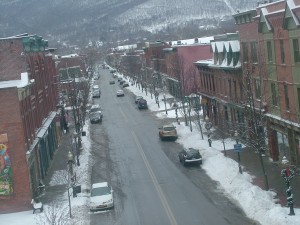
Beacon is the small American city that forgot to become woebegone when so many others have done just that. To a large degree, it also forgot to be a city.
It has been the city of Beacon since 1913 when the villages of Fishkill Landing and Matteawan merged, creating essentially an extended village where even today the tallest building is a six-story apartment and where the mayor believes there are only three elevators within city limits.
City taxes took a hit during the recession: about a $1 million tax revenue shortfall from all sources in 2010. “It’s a struggle the city has had to deal with, but it did not become a barrier to the city’s growth,” said Mayor Steven K. Gold. “In spite of the economy being at near-depression levels, there was a strong attraction for Beacon. Developers believed that when the economy got better, Beacon would be a place people would want to live and work. We’ve got natural beauty, a vibrant Main Street and a population of involved and enthusiastic residents. It has a character and an identity that people love.”

Beacon’s history was tied to dependable transportation via rail and the river, according to Gold, both of which remain fixtures. The Fishkill Correctional Facility east of the city encompasses the old Matteawan State Hospital, home to the criminally insane in bygone days ”“ including Harry Thaw, who killed architect Stanford White in the murder featured in the book “Ragtime” ”“ and is a major source of regional employment.
Grand Central Terminal is 70 minutes away via the super-express and the city has become a bedroom community for some of its 14,000 residents. The riverfront, which had fallen into neglect, last week saw a new harbor management plan delayed while code documents are tweaked, but the mayor said after the Feb. 22 City Council meeting he expects the plan to pass March 7.
Beacon does not lack for growth ”“ both tangible and planned ”“ but Gold stressed its village feel as critical and said he is not going to let that go.
Gold also informally declared his intention to seek a second term in November. He was elected in November 2007, following 18 years with Mayor Clara Gould in charge.
The city suffered a post-Industrial Revolution decline that is now providing the backbone of a number of projects, and not by happenstance. A crackdown initiated in 2007 on building code violations in large, underused buildings ”“ hitting owners hard as the downturn caught fire ”“ was painful, but it led to the buildings getting their leaks fixed. Now, four have been sold for adaptive reuse instead of being demolished, Gold said. Additionally, the old Beacon High School recently sold to developers and, in the mayor”™s words, “It will no longer be maintained by the taxpayers; it will now be part of the city”™s commercial tax base.” Envisioned is: housing, artist studios and gallery space.
Art, from small galleries to frequent exterior murals to the formidable Dia:Beacon in an old Nabisco packaging plant, is a big part of Beacon”™s vibrancy. The Beacon ”“ the Main Street movie palace ”“ is a notable gap-tooth, but that will change, Gold said. The city has partnered with Poughkeepsie-based 4th Wall Productions to fully restore the theater. He called it “one of our more romantic projects” and said, “in a few years, when it”™s fully restored, we see a large economic engine for the east end of Main Street.”
Unlike so many like-sized cities that have seen their main drags fizzle, Beacon boasts a vibrant (and exceptionally long) Main Street of old architecture, buttressed by an active arts community and restaurants. Facades include the classic Yankee Clipper Diner, where seven-year co-owner Katina Pertesis, welcomed customers on a recent snowy morning and said, “I love Beacon. The arts community here is great.” Her own classic American Main Street diner warrants accolades, as well. The previous evening witnessed the diner doing what it does best: “No problem at all,” said Pertesis, recalling the dad who ordered prime rib and the kid who wanted chocolate chip pancakes at the same time.

Reusing older buildings works tongue in groove with a policy of “reasonable and scalable” development. The theme is evident around the horn of Main Street along the once-industrialized Fishkill Creek, which drains 193 square miles of watershed and now being rediscovered. A December 2007 zoning law allows for a pair of housing developments, potentially 600 homes spread across four separate lots (one on the Hudson and three on the Fishkill Creek).
“There’s always a consequence to development,” Gold said. “Zoning changes prior to development have to be made with a great deal of thought because the result will be permanent.”
The city in July rejected a Metropolitan Transportation Authority-approved transit-oriented development (TOD) for the vicinity of the Beacon train depot. “It was too dense,” Gold said.
“The question is if changes will, in fact, disrupt our quality of life. We ”“ the City Council and the administration ”“ have to determine if concerns are based more on fear than fact. With the TOD, the public concerns with traffic, with too much business competition, with wrecked views, proved valid.” The city is now preparing its own TOD plan that it will submit to the MTA.
A “White House” ”“ so named ”“ at the south end of the city on a 60-acre riverfront parcel was recently gifted to Beacon. What might have been a white elephant, the White House instead has bartered full rent for repairs now being undertaken by the sloop Clearwater. When work is completed, the Clearwater will call Beacon home, providing a boost to Beacon. Gold estimated the free work at more than $200,000.
Farther north, the planned 166-room Long Dock Hotel and Conference Center is on hold, awaiting construction funding. It is integral to the city”™s harbor management plan (on hold until March 7). Scenic Hudson, the conservation organization, has already refurbished a park on the site, building a kayak center, re-establishing trails and vegetation and reinforcing the shoreline.
The full impact of the Beacon Institute for Rivers and Estuaries is tied up in waterfront revitalization, too.
The institute is gathering data, but its one active building is temporarily closed while its bridge over the railroad tracks is repaired. The city docks that are part of the institute’s berthing needs are less imminent in a world of tight budgets. “We are limited to essentials until finances improve,” Gold said.
The choices currently deferred, yet which likely will not disappear:
Ӣ a new highway department garage: estimated at $4 million;
Ӣ consolidating three firehouses into a single new one: estimated at $4 million;
Ӣ many roads to repair;
Ӣ a new bridge across the Fishkill Creek near the Hudson; and
”¢ new sewer lines: “Like all cities, we have areas where stormwater runoff and sewage combine. It”™s a very expensive process to fix it.”
Planning work, meanwhile, continues on the Mount Beacon Inclined Railway, which was closed by fire in 1978. Gold was co-founder along with Andy Chiusano, now deceased, of the Mount Beacon Inclined Railway Restoration Society. As it did with the hugely successful Poughkeepsie-Highland Railroad Bridge, the Dutchess-based Dyson Foundation is sponsoring the rail line”™s feasibility study.
Said Gold, “The feedback I get about Beacon”™s progress is very positive and very strong. Beacon is a city that sells itself. Looking forward, I”™d like to see Beacon be less of a bedroom community and more a center for work, which was its historic character.”

















A very healthy influence on Beacon has been Pete Seeger and his wife Toshi. Waterfront Park, the Beacon Sloop Club (free sails on the Sloop Woody Guthrie every summer evening), River Pool at Beacon (free dips in the Hudson for all, Tues-Sunday) and even the Scenic Hudson peninsula have their origins in the work and continuing participation of Pete. He still lives in the house he built 35 years ago on the ridge overlooking the Hudson and Beacon. Ninety-two in May, he still cuts his own wood and makes his own maple syrup.